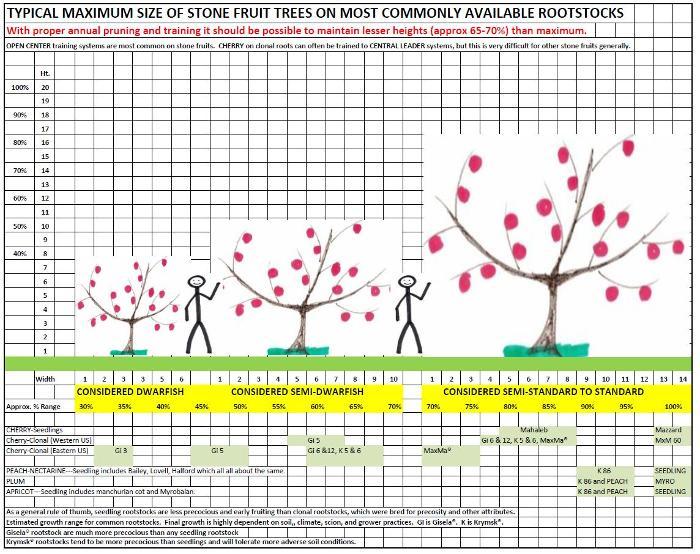RS-Cherry Rootstocks

RS-Cherry Rootstocks
Cherry Rootstocks now offer size control!
Extraordinary size control is now available with several lines of cherry rootstocks.
The trend in sweet cherry production is now away from standard (mazzard) rootstock and to several different lines of dwarfing cherry rootstocks. While it used to take up to 5 or more years for production to start on mazzard roots, now with Gisela(R), MaxMa(R) or Krymsk rootstocks production is hastened by many years, and the size of the tree can be more precisely controlled. Some of the rootstocks are so precocious and productive that new training and pruning systems must be employed in order to maintain consistent production and produce large size cherries. Over-cropping can be a problem with some rootstocks.
Tart cherry is still predominantly on mahaleb or mazzard rootstock for commercial production. There is research being done on higher density Montmorency tart cherry production on size-controlling rootstocks also.
We suggest you check out the resources of Michigan State University and Washington State University, where there is much research and extension information available on the new systems of sweet cherry production.
Listed in approximate order of dwarfing / size control--- results can vary with your site and the vigor of grafted scion.
Gisela® 5 USPP 9622 (148-2 cv) [45-60%]--- A very good, dwarfing rootstock for sweet cherries. Very precocious and early bearing. May need some support. More tolerant to virus infection than Mahaleb or Mazzard. Suitable for high density cherry systems where early production in the third year is expected. Needs more management of heavy fruit load than other rootstocks in order to maintain proper vigor and fruit size. More dwarfing on east coast than west coast. Poor general availability of sweet cherry varieties--- recommended for highly vigorous, but less productive clones. Usually ordered by contract.
Gisela® 6 USPP 8954 (148-1 cv) [65-90%]--- A precocious, semi-dwarfing stock very suitable for all sweet cherry varieties. Adapts well to all soil types and does very well on heavy soils. Open and spreading tree structure. Good virus resistance. No suckering. Support recommended, although it is well anchored. More dwarfing on east coast than west coast. Good availability of sweet cherry varieties, but order a year or more ahead.
Gisela® 12 USPP 9631 (195-2 cv) [65-90%]--- A precocious, semi-dwarfing stock very suitable for all sweet cherry varieties. Very similar in size to Gi 6. Adapts well to all soil types. Open and spreading tree structure. Good virus resistance. No suckering. Support recommended, although it is well anchored. More dwarfing on east coast than west coast. Increasing availability of sweet cherry varieties, but order a year or more ahead.
Maxma® 14 [70-75%]--- A newer dwarfing cherry rootstock that has just recently been reintroduced back into the U.S., where it was originally bred. Reported to be compatible with most sweet cherry varieties, precocious and productive. Tolerant of wet soils and iron chlorosis resistant. Limited availability of sweet cherry varieties-- recommended for testing at this time.
Mahaleb [90%]--- Typically used for tart cherries and some sweet cherries. Deep rooted, drought tolerant, cold hardy and highly productive. Susceptible to oak root fungus, root knot, and phytophthera. Best for light sandy soils--- do not use on heavy, poorly drained soils. The most productive rootstock for tart cherry. Not used often for sweet cherry, however a newer introduction from Europe called Mahaleb- CT 500 has improved genetic compatibility with most sweet cherry varieties. Mostly available on tart cherry--- very limited on sweet cherry.
Mazzard (Prunus avium) [100%]---The most common standard-size sweet cherry rootstock. Produces a very vigorous tree with good anchorage. Some tolerance to phytophthera and moderately resistant to oak root fungus. Will grow on a wide range of soils. Susceptible to crown gall and bacterial canker. Very few suckers. Typically used for sweet cherries, but also can be used for Montmorency and tart cherries to be planted in wetter, poorly drained sites where mahaleb cannot grow. Almost all sweet cherry varieties are available on Mazzard. Some tart cherry availability.
MxM® 60 (Prunux mahaleb x mazzard hybrid) [100%]--- A hybrid of mahaleb and mazzard that shows a wide range of soil compatibility. Has moderate resistance to phytophthera and crown gall and some tolerance to bacterial canker. Reported to be more productive than mazzard. Similar hardiness to mahaleb and compatible with both sweet and tart cherries. Often used in replant sites where it is reported to do better than either mahaleb or mazzard. Poor availability as it is in limited supply.